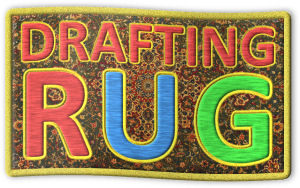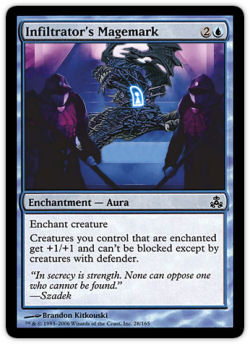Another Pro Tour Qualifier season is coming up, and the editor caught me between the end of my school exams and the start of a new series of Magic tournaments and testing. He asked me to put my thoughts on the RGD drafting format on paper. At first I was very hesitant, since up until the Pro Tour in Prague I’d had about 35% positive records in RGD drafts, with about 25 drafts in, and I don’t like to speak about a format without having had any success in it at all. Whether it is just the quality of the drafts I was in (90% of my draft preparation had been with seven guys that are all capable of winning a Pro Tour) or just a bad run, it has to mean something; results are the only real measure in this game. After the Pro Tour, I’ve done 5 drafts and the results of those are much better: three 3-0 and two 2-1. While it might not mean that much, especially since the level of drafting didn’t quite match the drafts I’d done before that, it brought some of my confidence back and definitely made me realize a few misconceptions that I had about the format.
In my experience, RGD is the hardest format I’ve played thus far (the first draft format I really played was Onslaught), as it discourages you from choosing your two colors in the first pack so you can stop worrying and just draft a good deck in the chosen two. With RGD, you need to be at least three colors if you want to have a Guild in all packs (or two out of three packs), and surely that’s what you’re aiming for. You might draft a two-color deck occasionally, but 95% of the decks are at least three colors.
Here’s the problem: in order to be able to pick the best of what you’re getting passed, you’ll want to be in a Guild the players passing you are not in… but that in no way guarantees you’ll get passed a certain Guild in future packs. Therefore it’s much harder to change your card evaluations in relation to what you already have, as most of the time the cards you get passed later on are unpredictable.
A common example of this problem is when you’ve drafted some Dimir cards pack 1, and in pack 2 have to choose between drafting Orzhov and Izzet. Drafting Dimir in pack 1 probably means you’ve passed a few good Boros cards, and a Boros drafter will also have to choose between the same two Guilds as you. Making a good decision here requires you to remember what you’ve passed — and your memory had better be good — as to anticipate what you might receive in the Dissension booster. Waiting too long to make that decision is not a good idea; you’re often forced to give up on a lot of card quality in order to keep your options open, or you could also choose to “go for it” and hopefully be able to switch in time if you’ve guessed wrong. If you do this, you probably will have passed some good cards in both the Guilds and confused your right-hand side neighbor, again not setting you up well for future picks.
This is not how I imagine you’d want to draft your deck, as there’s a good chance things could go wrong. Up until you’ve settled for a direction in the last booster, you will need to keep your eyes open; otherwise you might end up having missed out on a much better deck. This is why I think that the format is a lot harder that previous Limited offerings: you need to think ahead more than usual, leaving more room for error than normal.
A misconception that I had about the format was that aggressive decks with many good and efficient creatures were a lot less rare than I thought. I used to think that this format was like Sealed Deck… everyone playing many colors and expensive, powerful spells. As a result I picked removal and card advantage spells higher than most people, but I missed out on the good creatures and often ended up lacking in beef. I was almost always in either Black or Izzet, but sometimes I’d build into a four-color Green deck.
That brings me to Green, the color I like to draft a lot in this format, but now I prefer to draft it not as a control color or base for a many-color deck, but with many big creatures and a tight curve to support them.

A popular archetype, and also my favorite, is the Red/Green/Blue deck.
It has the two Guilds that may be the most powerful of all (Izzet and Simic), and combines it with Gruul, adding the synergy of Graft combined with Bloodthirst to the deck. Guildpact has two very powerful and popular Guilds; Izzet and Orzhov, which results in Gruul often being underdrafted. Simic is the key Guild of the deck, which means that if you’re passed Green and Blue in the first pack, you should attempt to give Green/Red/Blue a go.
Drafting RGU requires a lot of planning ahead, starting as early as your very first pick. You don’t have a Guild in the first booster, so if you want to try and be RGU you’re forced to give up some card quality, as you can’t pick up any of the more powerful multicolored spells. This doesn’t mean that Ravnica is the main weakness of the deck; there are still many cards that you want in your deck, but you should mainly focus on cutting the Blue cards. This will likely put you in a good position to pick up the Izzet cards in pack 2, and you’ll get to pass the many great Orzhov cards (which are exactly the opposite of what you’re drafting), again setting you up nicely for the next pack.
This brings me back to the issue that I brought up at the start of this article: having picked Blue cards means that one of your left-hand side neighbors might be in a Guild that shares a color with Izzet, which you obviously don’t want. Then again, if you and your neighbor are both picking up the Izzet cards, it’s become a lot easier to cut all of the good Izzet cards and it’s more likely for you to get the good Simic cards in Dissension. Besides, Guildpact has two Guilds for you to pick cards from, so it’s rare not to get enough good cards from the second pack.
The major strength of the RGU archetype, other than all-round great card quality, is the tremendous synergy there is between the three Guilds. A rule in every draft format is that there is no way you can draft and play 23 good cards; you always need a few mediocre cards to complete the deck. That’s why you should always be looking for a way to combine the later picks with one another. I’ll now highlight a few cards that aren’t very high picks but can really shine when you combine them with other cards that you might play in your deck.
Fists of Ironwood, Scatter the Seeds
Now that the Selesnya drafters have all but completely dried up, these two cards have dropped greatly in value. Both are very good with Vigean Hydropon, but Scatter the Seeds has now definitely become the better card as it turns any creature with Graft into a creature with Modular.
Doubling Season
It may seem a bit clunky, but if you have it and you pull it off, there’s no stopping you. I’ve seen it happen a few times: a Blue/Green player didn’t have many spells to play with but played Doubling Season on his fifth turn, turning all of his creatures into huge monsters. Since it’s usually only good in Blue/Green decks, I prefer more flexible cards early on in the draft, but it’s still definitely a terrific card in the right deck.

Infiltrator’s Magemark
I used to hate the card, but in a deck with many big guys and the ability to inflate smaller guys out of proportion, this Magemark is sometimes a risk worth taking. It can frequently put your opponent on a very short clock. In the previous format (RRG), decks containing both Blue cards and big guys were very rare, but the Simic Guild has brought them together, shifting the Magemark from only playable to a “sometimes great” card.
Bloodscale Prowler, Scab-Clan Mauler, Burning-Tree Bloodscale
The synergy between bloodthirsty creatures and the abilities of Graft creatures is obvious and amazing. In the common slot there are three Graft creatures that greatly improve the power of the Bloodthirst creatures: Sporeback Troll, Helium Squirter, and Aquastrand Spider, all of which you will always play anyway. They are even more valuable with your late-pick Bloodthirst creatures.
Flash Foliage
I’ve always played this card whenever I had it; there’s much more to it than most players notice at first sight. The creature you put into play with it can block any creature, including unblockable creatures, flying creatures, or any unblocked creatures (even after your opponent’s used Psychotic Fury for the win, yaus). You can use it to trader above its weight when you have a Grafter, or you can choose to keep the token by playing it when damage has already been put onto the stack.
Psychotic Fury
Narrower than other combat tricks, its effect is very powerful to make up for that. It’s a very good thing that you’ll see this card as late as 40th pick in the draft, because obviously it depends very heavily on how many good targets you have in your deck. I’m not sure how many targets you need to justify running Psychotic Fury; I guess it depends on how desperate you are to get tricky in combat, and how much fun you want to have with your Wee Dragonauts.
Overall, the Red/Green/Blue archetype can be very powerful, and you should definitely try to draft it when you get the opportunity, but you should also be aware that if you don’t set up the second and third pack of the draft properly, things could go awry if your neighbors cut your good cards. You’ll end up with an awkward many-color deck with misplaced aggressive cards.
I definitely find RGD to be a difficult format, perhaps the only format in which Rochester draft is easier than Booster draft. I’ve drafted too many decks that were looking good in the first pack, but then completely died in Guildpact because of a first pick Steamcore Weird, second pick Blind Hunter, and so on. Keeping your options open is a good thought, but at some point you’re going to have to take the Pillory of the Sleepless over Douse in Gloom if you want to win more matches.
My advice to you is to keep practicing, try to remember accurately what you’ve passed, and anticipate what you could receive in the next pack as a result of that. Also, you should never talk about the draft — or even vaguely communicate – no matter how casual the draft is; our weekly Monday night draft has been influenced a lot just by players saying “huh?” or “man!” The best place for draft talk is after the draft and this format can bring up an interesting discussion because you’re required to make so many choices during the draft.
Good luck at your Pro Tour Qualifier or Grand Prix!
